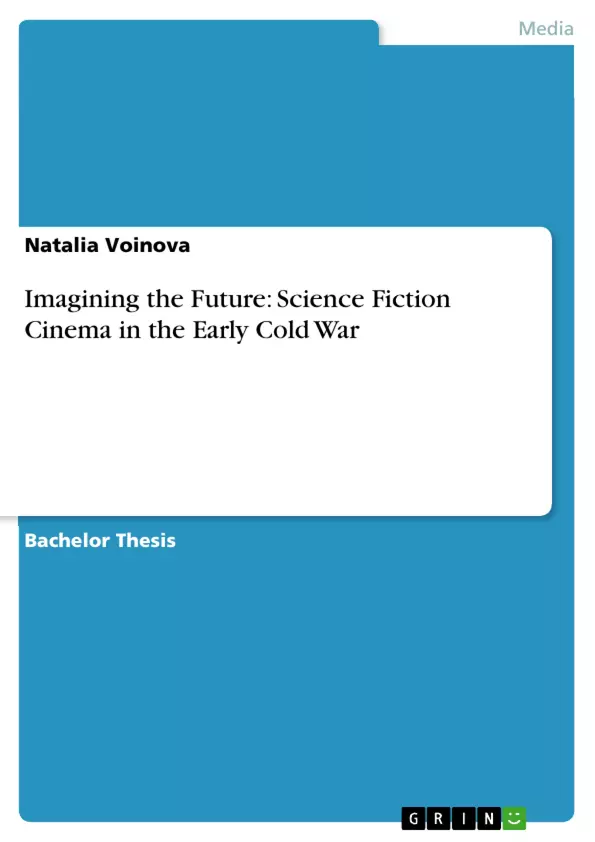Science fiction is always political as it has the power to stage contemporary problems through the lens of impossible events, it imagines theoretical futures out of present issues. The essay will compare the use of science fiction in cinema in the USSR and the United States of the late 1950s and 1960s to coincide with the period of de-Stalinisation and thaw in the USSR, and late McCarthyism in the United States.
The genre provides an opportunity to express the scientific stand-off between the two powers through fiction, it is also a vehicle for dissemination of ideas and propaganda. Post-1956, when the period of de-Stalinisation officially began, science fiction saw a carefully crafted rebirth as a tool to reflect the socialist ideal and quasi-religious faith in science promoted by the Party. Science fiction uniquely demands for an imaginative view of the future, which corresponds with the Marxist- Leninist future-oriented ideology.
The fear of external influence from the enemy for both countries results in heavily ideological cinema, especially in the sci-fi genre as an imagined reflection of contemporary issues onto a fictional future. The themes for American science fiction of this period are hyperbolised monsters and invasion, which reflect the fear of the otherness of the Soviet Union and its threat on domestic ideals. Soviet science fiction films focus on the heroic Soviet man, who frequently receives calls for help from outer space and overcomes great trials to save those not living in utopia.
Inhaltsverzeichnis (Table of Contents)
- Ideologies in Science Fiction
- On the Home Front
- Where No Man Has Gone Before
- Conclusion
Zielsetzung und Themenschwerpunkte (Objectives and Key Themes)
This essay explores the use of science fiction in cinema during the late 1950s and 1960s in the USSR and the United States, focusing on the period of de-Stalinisation and thaw in the USSR, and late McCarthyism in the United States. The goal is to compare the ways in which the genre reflects the scientific stand-off between the two superpowers and serves as a tool for disseminating ideologies and propaganda.
- The political nature of science fiction and its ability to reflect contemporary issues.
- The role of science fiction in shaping ideologies and disseminating propaganda.
- The influence of the Space Race and the Cold War on science fiction cinema.
- The differing thematic focuses of American and Soviet science fiction, including fears of alien invasion and the celebration of socialist utopia.
- The use of science fiction as a means of social critique, representing different political perspectives.
Zusammenfassung der Kapitel (Chapter Summaries)
The first chapter, "Ideologies in Science Fiction," examines the genre's inherent political nature, highlighting its ability to stage contemporary problems through the lens of impossible events. It explores how science fiction films, particularly in the 1950s and 1960s, served as a conduit for ideologies, shaping the imaginative minds of youth.
The second chapter, "On the Home Front," focuses on the influence of the Cold War on science fiction cinema in both the United States and the Soviet Union. It analyzes the contrasting themes of fear and paranoia in American science fiction, often depicted through alien invasion narratives, and the celebration of socialism and technological advancement in Soviet films.
The third chapter, "Where No Man Has Gone Before," delves further into the social critique offered by science fiction cinema, examining how different political viewpoints were reflected in the genre. Left-wing films often glorified scientists and criticized fear of the unknown, while right-wing films emphasized the importance of the military and amplified anxieties.
Schlüsselwörter (Keywords)
This essay focuses on the keywords: science fiction, Cold War, ideology, propaganda, cinema, USSR, United States, de-Stalinisation, McCarthyism, Space Race, alien invasion, utopia, social critique, political perspectives.
- Quote paper
- Natalia Voinova (Author), 2012, Imagining the Future: Science Fiction Cinema in the Early Cold War, Munich, GRIN Verlag, https://www.hausarbeiten.de/document/201328


